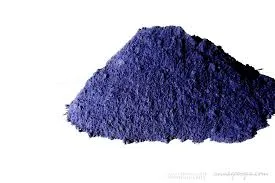best dark blue natural dye
The Allure of Dark Blue Exploring Natural Dyes
Natural dyes have graced humanity since the dawn of civilization, enriching textiles, artwork, and crafts with their vibrant hues. Among these, dark blue is particularly enchanting, blending elegance with depth, and holding significant historical and cultural importance. This article delves into the world of best dark blue natural dyes, their sources, application, and the resurgence of interest in sustainable practices.
The Quest for Dark Blue
Historically, the quest for a true dark blue dye was a challenging one. Unlike other colors, which could be sourced from a variety of plants and minerals, creating a rich, deep blue required specific conditions and materials. The most celebrated dark blue dye comes from indigo. Derived from the leaves of the indigo plant, which flourishes in various regions—including Africa, Asia, and the Americas—this dye has been pivotal in textile production for thousands of years.
Indigo's journey from plant to pigment is fascinating. The leaves are fermented to convert the indican compound into indigo dye, a process that has been perfected over centuries. The resulting dye is incredibly stable and has a unique ability to deepen with each dyeing cycle, creating layers of color that are both rich and complex.
Other Natural Sources of Dark Blue Dyes
While indigo is the king of dark blue, there are other natural sources worth mentioning. One such source is woad (Isatis tinctoria), a plant historically used in Europe before the introduction of indigo. Woad produces a similar blue hue, albeit with a somewhat greener tint. Its use dates back to ancient times, particularly among the Celts. Although less popular today, woad is making a comeback among artisans seeking to preserve traditional dyeing techniques.
Another lesser-known source is blueberry (Vaccinium spp.), which can produce a range of blue to purple shades, depending on the mordant used. While blueberry doesn’t reach the depth of indigo, it’s a viable option for those who prefer to work with accessible and edible plants.
The Art of Natural Dyeing
best dark blue natural dye

The process of natural dyeing involves several steps that require a tactile relationship with materials and a mindful approach to color. To achieve a vibrant dark blue, textile artists typically use a mordant—such as alum or iron—to help fix the dye to the fabric. Different mordants can alter the final shade, enabling a spectrum of blue hues; using iron, for instance, can result in a darker, more muted blue.
Dyeing is usually conducted in two stages the first involves soaking the fabric in a mordant solution, followed by immersing it in the indigo dye bath. After the initial dyeing, air exposure leads to a chemical reaction that gradually reveals the rich blue color. This unique process, where the fabric is repeatedly dipped, produces complex layers of color that are impossible to replicate with synthetic dyes.
Sustainable Practices and Modern Applications
In an era where fast fashion dominates the market, the resurgence of interest in natural dyes represents a powerful shift toward sustainability. As consumers become more aware of environmental issues, many are seeking out natural dyes for both their eco-friendly properties and the unique qualities they bring to textiles.
Using natural dyes not only reduces reliance on synthetic chemicals but also encourages biodiversity and traditional agricultural practices. Cultivating plants like indigo and woad supports local farmers and maintains ancient knowledge and craftsmanship that might otherwise be lost.
Contemporary artisans and designers are now integrating these practices into their work. Fashion brands that utilize natural dyes often emphasize their commitment to ethical production, appealing to a growing demographic that values sustainability alongside aesthetics.
Conclusion
The world of dark blue natural dyes, particularly indigo, is a rich tapestry woven from history, culture, and environmental consciousness. As we reconsider our relationship with color and materials, the allure of these deep, captivating hues continues to inspire artisans, designers, and consumers alike. By embracing the timeless techniques of natural dyeing, we not only revive traditions but also forge a path toward a more sustainable and thoughtful future in fashion and textiles. As we move forward, the depth of dark blue—rooted in nature—invites us to reflect on its beauty and significance in our lives.
-
The Timeless Art of Denim Indigo Dye
NewsJul.01,2025
-
The Rise of Sulfur Dyed Denim
NewsJul.01,2025
-
The Rich Revival of the Best Indigo Dye
NewsJul.01,2025
-
The Enduring Strength of Sulphur Black
NewsJul.01,2025
-
The Ancient Art of Chinese Indigo Dye
NewsJul.01,2025
-
Industry Power of Indigo
NewsJul.01,2025
-
Black Sulfur is Leading the Next Wave
NewsJul.01,2025

Sulphur Black
1.Name: sulphur black; Sulfur Black; Sulphur Black 1;
2.Structure formula:
3.Molecule formula: C6H4N2O5
4.CAS No.: 1326-82-5
5.HS code: 32041911
6.Product specification:Appearance:black phosphorus flakes; black liquid

Bromo Indigo; Vat Bromo-Indigo; C.I.Vat Blue 5
1.Name: Bromo indigo; Vat bromo-indigo; C.I.Vat blue 5;
2.Structure formula:
3.Molecule formula: C16H6Br4N2O2
4.CAS No.: 2475-31-2
5.HS code: 3204151000 6.Major usage and instruction: Be mainly used to dye cotton fabrics.

Indigo Blue Vat Blue
1.Name: indigo blue,vat blue 1,
2.Structure formula:
3.Molecule formula: C16H10N2O2
4.. CAS No.: 482-89-3
5.Molecule weight: 262.62
6.HS code: 3204151000
7.Major usage and instruction: Be mainly used to dye cotton fabrics.

